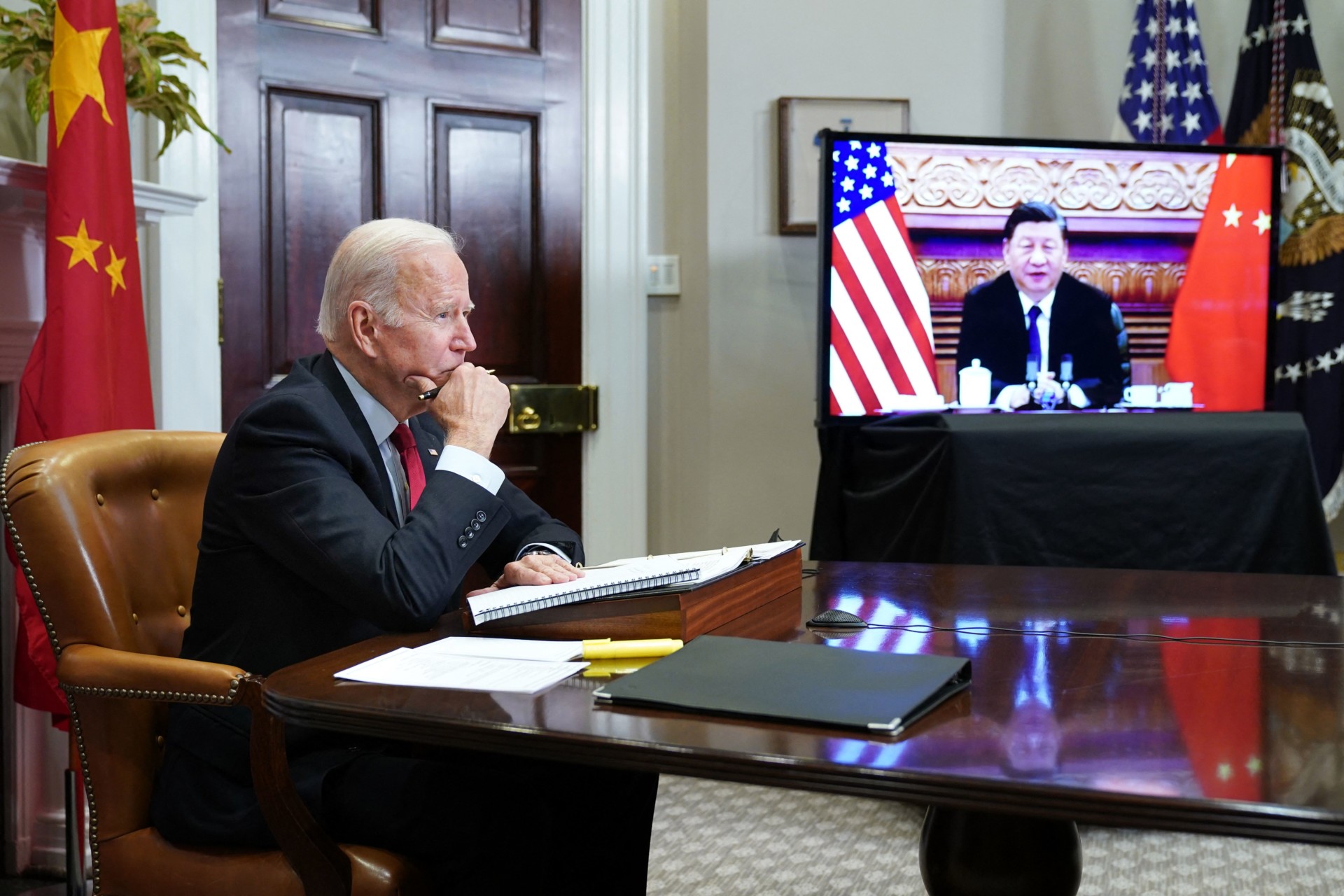Cooperation on issues such as security and counterterrorism could serve as a foundation for Beijing and Washington to address areas of geopolitical tension.
There is no shortage of disputes in the intensifying great-power competition between the U.S. and China, many of which were discussed between U.S. President Joe Biden and Chinese President Xi Jinping during their first virtual summit on Nov 15. From Taiwan to trade to North Korea, such contentious issues are unlikely to dissipate anytime soon. But while tensions between the two are perhaps inevitable, there is a path forward for Washington and Beijing to mitigate the most disruptive elements of their rivalry and focus on practical cooperation in areas of shared interest, particularly over transnational security threats.
Drivers for Competition
There are two fundamental and interrelated elements that drive the standoff between the U.S. and China: geopolitics and national values. From a geopolitical perspective, there is a certain ingrained level of tension between the two countries regardless of who is in power in Beijing or Washington. This stems from the U.S. geopolitical imperative to prevent the rise of a regional hegemon in Eurasia that could challenge the country’s global power status, a role that has been played over the past century by various Eurasian powers – from Nazi Germany to Imperial Japan to the Soviet Union – all of which the U.S. confronted either directly or by proxy.
Simply by virtue of the size of the Chinese economy, which has grown exponentially over the past four decades ever since its launch of free-market reforms in 1978, China now plays that role. Given that economic power traditionally serves as a conduit for political and military power, the U.S. would likely have a wary eye on a rising China no matter what form its government took. China’s demographic, economic, and military heft all demand U.S. attention, with Washington having to factor in Beijing’s capabilities regardless of its rhetoric or intentions.
At a strategic level, the policies pursued by the administrations of Biden and Xi reflect these inherent tensions in the contemporary era. China’s own geopolitical imperatives – which include domestic political consolidation, seeking protection from its neighbors and external powers, and building up regional and global influence – all have strategic manifestations that the U.S. interprets negatively. Whether it is China’s handling of protests in Hong Kong or its military maneuvers near Taiwan or its growing economic influence globally – from pursuing the Belt and Road Initiative to advocating for greater representation in international institutions – all of these developments are seen by Washington as power plays that pose a challenge to the U.S. These, in turn, shape the strategy of the U.S. at multiple levels, playing a key role in Biden’s focus on infrastructure on the domestic front while driving greater U.S. engagement in the Indo-Pacific arena. It is likely no coincidence that the U.S. signed the AUKUS nuclear submarine deal within weeks of its final withdrawal from Afghanistan, signaling that its primary security focus has decisively shifted toward China and the Asia-Pacific theater.
Adding a layer of complexity to the geopolitical and strategic components of the U.S.-China rivalry are divergent values systems and ideologies in the two countries. China’s Confucianist heritage places emphasis on collectivism, order, and hierarchy as national values. The U.S., with its liberal democratic traditions, places emphasis on individualism and views authority with skepticism, preferring a process-oriented approach while China pursues results-oriented policies. In a political sense, this plays out in the form of the U.S. promoting its values of human rights and democracy around the world, which clashes both with China’s own unique interpretation of human rights and with the Chinese Communist Party’s emphasis on non-interference in the domestic affairs of other countries.
The Dispute over Xinjiang
One particularly sensitive case where these geopolitical, strategic, and values-based differences intersect is in the Western Chinese region of Xinjiang. The U.S. has criticized China over its treatment of the ethnic minority Uyghur population, with Washington accusing Beijing of ethnic and religious crackdowns on the Uyghurs and their forced detention and “re-education” in labor camps. The U.S. has also passed sanctions against China and restricted imports from Xinjiang, including agricultural goods and solar panels.
For China, such actions cross a red line. Domestic consolidation is a crucial component of China’s geopolitical imperatives, and Xinjiang has historically been a restive province (one that was incorporated into China only relatively recently, in the late 19th century). There have been countless rebellions, protests, and militant attacks from the region, framing Beijing’s security-minded approach to Xinjiang. What’s more, the region serves as a key component of China’s strategy to boost economic growth within the country’s relatively underdeveloped interior and is a springboard for crucial Belt and Road Initiative routes to Central Asia.
Thus for Beijing, U.S. pushback against China’s domestic policy in Xinjiang not only represents a difference of values but also strikes at the heart of several of Xi’s strategic objectives. China views U.S. actions and criticism on Xinjiang as both an ideological issue and an element of the U.S. trying to curb Beijing’s power and foster internal divisions within China. Furthermore, some in China question why the U.S. has put so much focus on Xinjiang only recently, when the dynamics of China’s policies have been in play for many years, suggesting a geopolitical dimension to U.S. actions rather than being solely based on human rights and democracy.
Points of Connection
Despite these differences, it is not inevitable that Washington and Beijing are destined to clash in a “New Cold War.” Indeed, this analogy is in many ways misplaced. Unlike the Soviet Union, China is no longer trying to export its Communist ideology, and Beijing is not trying to dominate the global system as much as it is trying to reshape it in order to have a larger voice within key international institutions like the International Monetary Fund, World Bank, and World Trade Organization. Additionally, the current global system is increasingly multipolar, as opposed to the bipolar world of the U.S. and Soviets during the Cold War. While the U.S. and China are the two largest powers, there are several other players that are highly influential in shaping the global system, including Russia, the EU, Turkey, India, and Japan, all of which have a certain level of autonomy and thus factor heavily into U.S. and Chinese decision-making.
Furthermore, the U.S. and China are significantly more interconnected economically than were the U.S. and Soviet Union. Despite their geopolitical frictions, trade and investment between the two countries has remained high even in the COVID-19 era. While there are calls for economic decoupling, both sides would suffer heavily as a result, and economic interdependence is important as a constraining factor to any significant provocative actions by the U.S. or China, be it military action over Taiwan or other major acts of disruption.
This interconnectedness also applies to the security realm. Following the U.S. withdrawal from Afghanistan, the threat of the spillover of militancy or proliferation of terrorist groups is one that is felt not only by the U.S. and the West, but also increasingly by China as well. China not only has its own direct border with Afghanistan but also has significant economic interests to the immediate north of the country in the region of Central Asia, which has long been vulnerable to the flows of militancy and narcotics from Afghanistan.
A more constructive and effective path forward for China and the U.S. would be to balance their inherent strategic and values-based differences by identifying areas of mutual and overlapping interest and cooperating in practical ways on those issues. One such area is Afghanistan, where both the U.S. and China have a shared interest in combatting the proliferation of transnational terrorism – whether that be the Islamic State, Al Qaeda, or even groups that contain Uyghurs among their members. Counter-terrorism cooperation in Afghanistan, such as intelligence sharing, joint tactical exercises, or logistical collaboration, could thus serve as a basis for jointly addressing shared interests between Washington and Beijing and perhaps even mitigate some of the acute tensions between the two countries over Xinjiang. This could also spur momentum in other areas of joint interest, such as combating climate change.
Of course, both the U.S. and China have domestic political constraints that will make any major breakthroughs difficult and could drive the leadership to take increasingly hawkish positions. But for the U.S., the reality is that relying solely on criticism and pressure against China – whether in Xinjiang, Hong Kong, Taiwan or elsewhere – could prove harmful to its interests and the very value systems it is trying to protect. Punitive actions such as sanctions, trade restrictions, and diplomatic criticism have only reinforced China’s behavior and driven it further away from the U.S., even as Beijing has developed closer ties to other U.S. adversaries like Russia and Iran.
The same goes for China, as simply criticizing the U.S. for being hypocritical about its own human rights violations exacerbates tensions without producing concrete results.
To be sure, there is much that China and the U.S. will continue to disagree about moving forward. But pressure and punitive actions should be balanced with practical and concrete forms of engagement by both sides, particularly when it comes to shared security threats. This way, the U.S. and China can both uphold their respective values while safeguarding their strategic interests, preventing and mitigating the most disruptive elements of their competition while enhancing cooperation and fostering a more stable global order.
Eugene Chausovsky is a Nonresident Fellow with the Newlines Institute. Previously, he served as Senior Eurasia Analyst at Stratfor for 10 years. His work focuses on political, economic, and security issues pertaining to the former Soviet Union, Europe, and Latin America. He Tweets at @EugeneChausovsk.
The views expressed in this article are those of the author and not an official policy or position of the New Lines Institute.





